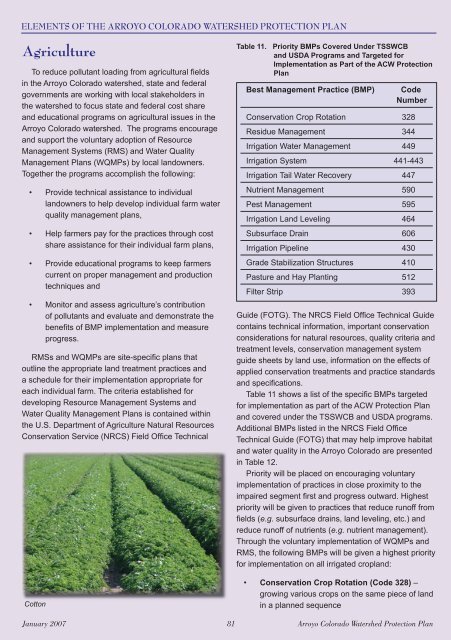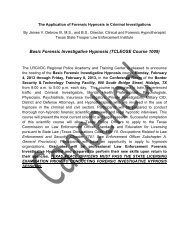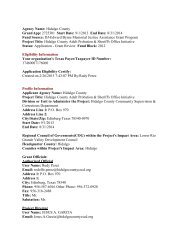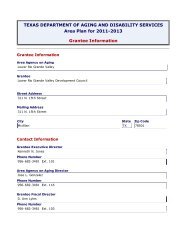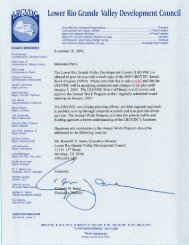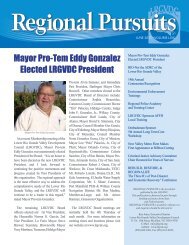Watershed Protection Plan - Lower Rio Grande Valley Development ...
Watershed Protection Plan - Lower Rio Grande Valley Development ...
Watershed Protection Plan - Lower Rio Grande Valley Development ...
Create successful ePaper yourself
Turn your PDF publications into a flip-book with our unique Google optimized e-Paper software.
ELEMENTS OF THE ARROYO COLORADO WATERSHED PROTECTION PLAN<br />
Agriculture<br />
To reduce pollutant loading from agricultural fi elds<br />
in the Arroyo Colorado watershed, state and federal<br />
governments are working with local stakeholders in<br />
the watershed to focus state and federal cost share<br />
and educational programs on agricultural issues in the<br />
Arroyo Colorado watershed. The programs encourage<br />
and support the voluntary adoption of Resource<br />
Management Systems (RMS) and Water Quality<br />
Management <strong>Plan</strong>s (WQMPs) by local landowners.<br />
Together the programs accomplish the following:<br />
• Provide technical assistance to individual<br />
landowners to help develop individual farm water<br />
quality management plans,<br />
• Help farmers pay for the practices through cost<br />
share assistance for their individual farm plans,<br />
• Provide educational programs to keep farmers<br />
current on proper management and production<br />
techniques and<br />
• Monitor and assess agriculture’s contribution<br />
of pollutants and evaluate and demonstrate the<br />
benefi ts of BMP implementation and measure<br />
progress.<br />
RMSs and WQMPs are site-specifi c plans that<br />
outline the appropriate land treatment practices and<br />
a schedule for their implementation appropriate for<br />
each individual farm. The criteria established for<br />
developing Resource Management Systems and<br />
Water Quality Management <strong>Plan</strong>s is contained within<br />
the U.S. Department of Agriculture Natural Resources<br />
Conservation Service (NRCS) Field Offi ce Technical<br />
Cotton<br />
Table 11. Priority BMPs Covered Under TSSWCB<br />
and USDA Programs and Targeted for<br />
Implementation as Part of the ACW <strong>Protection</strong><br />
<strong>Plan</strong><br />
Best Management Practice (BMP)<br />
Code<br />
Number<br />
Conservation Crop Rotation 328<br />
Residue Management 344<br />
Irrigation Water Management 449<br />
Irrigation System 441-443<br />
Irrigation Tail Water Recovery 447<br />
Nutrient Management 590<br />
Pest Management 595<br />
Irrigation Land Leveling 464<br />
Subsurface Drain 606<br />
Irrigation Pipeline 430<br />
Grade Stabilization Structures 410<br />
Pasture and Hay <strong>Plan</strong>ting 512<br />
Filter Strip 393<br />
Guide (FOTG). The NRCS Field Offi ce Technical Guide<br />
contains technical information, important conservation<br />
considerations for natural resources, quality criteria and<br />
treatment levels, conservation management system<br />
guide sheets by land use, information on the effects of<br />
applied conservation treatments and practice standards<br />
and specifi cations.<br />
Table 11 shows a list of the specifi c BMPs targeted<br />
for implementation as part of the ACW <strong>Protection</strong> <strong>Plan</strong><br />
and covered under the TSSWCB and USDA programs.<br />
Additional BMPs listed in the NRCS Field Offi ce<br />
Technical Guide (FOTG) that may help improve habitat<br />
and water quality in the Arroyo Colorado are presented<br />
in Table 12.<br />
Priority will be placed on encouraging voluntary<br />
implementation of practices in close proximity to the<br />
impaired segment fi rst and progress outward. Highest<br />
priority will be given to practices that reduce runoff from<br />
fi elds (e.g. subsurface drains, land leveling, etc.) and<br />
reduce runoff of nutrients (e.g. nutrient management).<br />
Through the voluntary implementation of WQMPs and<br />
RMS, the following BMPs will be given a highest priority<br />
for implementation on all irrigated cropland:<br />
• Conservation Crop Rotation (Code 328) –<br />
growing various crops on the same piece of land<br />
in a planned sequence<br />
January 2007 81 Arroyo Colorado <strong>Watershed</strong> <strong>Protection</strong> <strong>Plan</strong>


